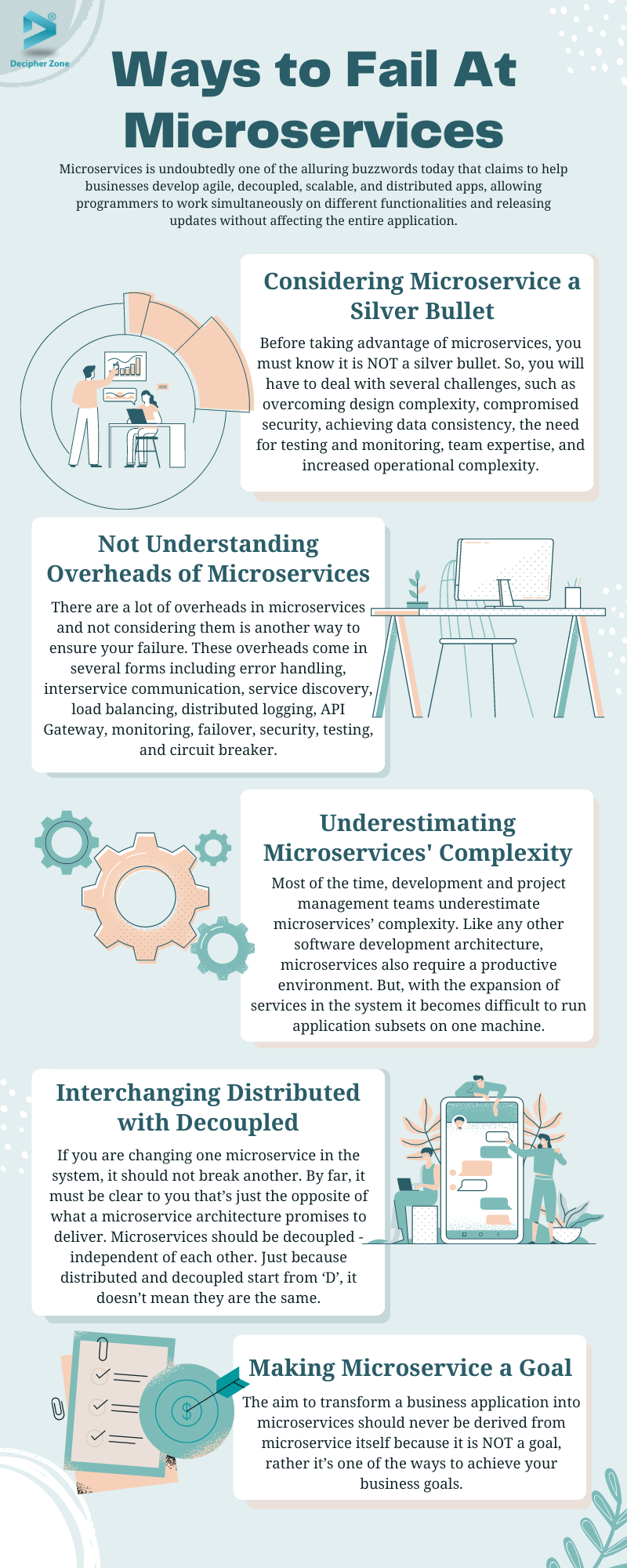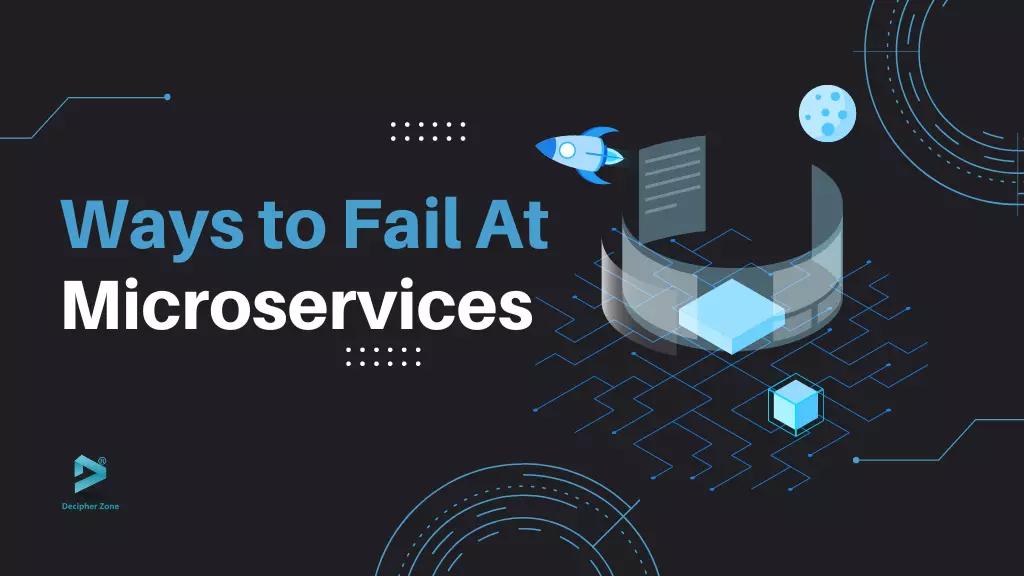Microservices is undoubtedly one of the alluring buzzwords today that claims to help businesses develop agile, decoupled, scalable, and distributed apps, allowing programmers to work simultaneously on different functionalities and releasing updates without affecting the entire application.
While some organizations have successfully achieved this, others don’t. Why? Well, it turns out that distributing an app across multiple containers is not enough. Many of us haven’t even realized that distributed applications are not a synonym for decoupled applications.
Read: Addressing the Microservices States, Scalability, and Streams
Needless to say, if not done correctly, this architecture can lead you quickly into trouble. But, before starting on the ways one can fail at microservices, it is crucial to know what microservices are. For reference, you can read one of our previously written blogs, “Why Microservice Architecture?”.
In this post, we intend to share some observations from the implementation and maintenance of microservice architecture-based applications that could have failed the application if not rectified on time.
Top 8 Ways To Ensure Failure of Microservices
As business owners or developers, wanting to try shiny and trendy tools and technologies is our natural tendency. But, what we think works wonders can cause our downfall. So, let's understand how one can fail at microservices with grace.
Read: How to Build Microservices in Java
1. Considering Microservice a Silver Bullet
What is essential to hunt vampires? Silver. Or shall we say Silver Bullets - a magical weapon to kill all vampires?
Well, as software developers, we know a few vampires lurking around the dark and creepy corners and threatening the success of our projects - deeply embedded bugs, incomplete documentation, application complexity, scalability, long development cycle, and whatnot. But does that make microservice a silver bullet?
With so many promises that microservice comes with, including but not limited to enhanced development speed and productivity, some believe it can solve most problems in software development. But, what we tend to neglect here is the complexity that working with microservices involves.
Before taking advantage of microservices, you must know it is NOT a silver bullet. So, you will have to deal with several challenges, such as overcoming design complexity, compromised security, achieving data consistency, the need for testing and monitoring, team expertise, and increased operational complexity.
2. Not Understanding Its Overheads
There are a lot of overheads in microservices and not considering them is another way to ensure your failure. These overheads come in several forms including error handling, interservice communication, service discovery, load balancing, distributed logging, API Gateway, monitoring, failover, security, testing, and circuit breaker.
Read: What are the Pros and Cons of Microservices
For most of these overheads, the Open Source Software integration by Netflix can be a solution. While solving other overheads like distributed logging, monitoring, and distributed transactions is more difficult as the requests can be in multiple spans and you will have hundreds of services to monitor.
However, microservices allow us to use the right technologies like Saga pattern, Prometheus, correlation IDs, etc. for each service according to their requirements. So that we can improve the performance of the application. But before using such techniques, tools, and technologies one needs to understand and ensure that they are being implemented in the right way.
3. Underestimating its Complexity
Most of the time, development and project management teams underestimate microservices’ complexity. Like any other software development architecture, microservices also require a productive environment. But, with the expansion of services in the system it becomes difficult to run application subsets on one machine.
Read: Benefits of Microservices Architecture
So, it becomes essential to provide your team with a reasonable machine to work, while ensuring to use build tools like Jenkins, Maven, or Gradle for each service, and use multiple Docker files to spin different services with all configured volumes and ports. Also, if you are working with Docker and using a container orchestration tool like Kubernetes, invest in some debugging tools of its cluster.
4. Using Shared Services for Local Development
Sometimes to overcome poor local development processes, most teams begin to rely upon shared environments for pivotal services like messaging queues, databases, or centralized cache. While most newbie developers don’t realize how problematic sharing services for development can be.
Read: Event-Driven Microservices using Java Spring Boot Cloud Stream
Some of the basic problems one can face while sharing services are fear of data being wiped out by another developer, no service experiments to come up with performance tuning, difficult service isolation, inconsistency, no change traceability, and difficulty working remotely when you are not connected to the network.
The best way to overcome such a microservice failure is to run these services on containers and version control systems.

5. Not Preparing For Failures
So far we have learned that microservices reduce the risk of failure, i.e. when any part of the system fails, it does not disrupt or stop the entire application from running.
Read: Microservices vs API
While microservices can make the system less prone to failure, you still need to design with failure in mind. Why? Because there are still some inescapable dependencies that a system might have that can impact another service. Hence, by creating a system ready for failures, you will be able to handle slow services, unexpected downtimes, and responses.
6. Making Microservice a Goal
Another common problem that developers face is ‘microservice envy’. While microservices are not something that businesses should envy, it has become quite common. Even without knowing what it would do, clients keep talking about using Microservices just because Netflix, Amazon, Uber, or some other top brands are doing so. Needless to say, that’s not the right reason to switch your web application to microservices.
Read: What are the Top best Tools for Monitoring Microservices
On the other hand, if the client has a great understanding of cohesion and coupling, and wants to add those things to their application, only then using microservices can be justified.
The aim to transform a business application into microservices should never be derived from microservice itself because it is NOT a goal, rather it’s one of the ways to achieve your business goals.
7. Interchanging Distributed with Decoupled
If you are changing one microservice in the system, it should not break another. By far, it must be clear to you that’s just the opposite of what a microservice architecture promises to deliver. Microservices should be decoupled - independent of each other. Just because distributed and decoupled start from ‘D’, it doesn’t mean they are the same.
Read: Observability for Monitoring, Tracing Lineage in Microservices
While it is entirely possible to have a distributed system with all the cons that come from being distributed while being completely tangled and coupled with other services.
That’s why a basic principle of the microservice state is to let go of ‘Don’t Repeat Yourself’ or DRY while staying away from having common libraries as they can lead to coupling of services.
8. Thinking Granularity Will Solve Everything
While working with Microservices, we expect that dividing and fragmenting services will solve every problem like deployment delays, system security risks, and development sluggishness.
However, in reality, it is a must to avoid getting too granular with microservices in the initial development stage. Instead, you need to take it slowly toward microservices while solving performance problems.
One of the common mistakes that led to microservice failure is nonetheless becoming too granular with different services and technologies, making code maintenance, testing, monitoring, and handling difficult in the long run.
In the worst-case scenario, it can lead to the very same problem you wanted to escape with other architectures.
.png)
Conclusion
So, those were some best ways to fail at microservices with ease. We hope you enjoyed the blog and learned crucial aspects of microservices from it.
Remember to do your research before opting for microservices and only start working with them if you find them useful for your unique business project scenario.
Simply put, understand what you want from the web application, and don’t follow the unknown territory blindly. Most importantly, make sure that the development team that you are hiring is up to the task, and has the required resources and tools.
Ready to transform your dream into reality?
Then get in touch with our team and share your business ideas with industry experts to acquire an incredible offer that matches your organizational needs NOW!

